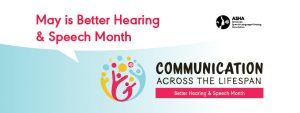May is Better Hearing and Speech Month
The American Speech-Language-Hearing Association (ASHA) designates May as Better Hearing and Speech Month (BHSM). Since 1927, BHSM is celebrated to provide parents, educators and the community with information to raise awareness about communication disorders, help identify those in need of life-altering treatment and to explain the role of a speech-language pathologist. Below is a brief overview of each of those topics.

In honor of Better Hearing and Speech Month, Denver Speech Language Solutions will be providing free speech and language screenings for families who are concerned about their child’s speech-language development. Scroll to the bottom of this post for more information on free screenings.
What are communication disorders?
Communication disorders are an impairment that affects a person’s ability to communicate. Communication disorders cause problems with speech, language, and/or hearing and may range in severity from mild to profound. These disorders can be developmental or acquired.
Types of Communication Disorders
- Language Disorder: difficulty understanding or processing language (receptive), difficulty using language (expressive) or difficulty with social communication (pragmatic language).
- Articulation Disorder: inability to correctly produce speech sounds (phonemes) because of the imprecise placement, timing, pressure, speed, or flow of movement of the lips, tongue, or throat.
- Fluency disorder: interruption of the flow of speech such as hesitations, repetitions or prolonging sounds or words.
- Voice Disorder: problems with the pitch, volume or quality of the voice.
- Hearing Disorder: impaired auditory sensitivity of the physiological auditory system.
- Central Auditory Processing Disorder: deficits in the information processing of audible signals not attributed to impaired peripheral hearing sensitivity or intellectual impairment.
What are signs that your child may need speech-language therapy?
- He/she is difficult to understand.
- He/she is not yet imitating sounds or words.
- He/she is not yet saying enough words or combining words independently.
- He/she is not yet using appropriate sentence structure.
- He/she has difficulty following directions and/or answering simple questions.
- He/she has difficulty communicating in social settings.
- He/she “gets stuck” on sounds, words, or phrases.
- He/she has a limited repertoire of food types and food groups.
- He/she repeats words or syllables frequently.
- He/she has difficulty making eye contact.
- He/she has difficulty putting words together with simple sentence structures.
What should you do if you think your child may have a communication disorder?
If you think your child is having trouble with communication, consult with a licensed speech-language pathologist (SLP). The SLP will administer a comprehensive speech-language evaluation to assess your child’s articulation and language skills. When the evaluation is completed, the SLP will determine if speech-language therapy is recommended based on the results of the evaluation.
How does early identification help with treatment of communication disorders?
It is important not to wait for your child to outgrow their speech and language concerns. Early intervention can be an integral part of the process, so it’s important to begin treatment as soon as possible. Communication disorders can negatively impact a child’s ability to read, write, learn and socialize. ASHA says: “The earlier a child’s speech and language problems are identified and treated, the less likely it is that problems will persist or get worse. Early speech and language intervention can help children be more successful with reading, writing, schoolwork, and interpersonal relationships.”
What is speech-language pathologist?
A speech-language pathologist is a licensed, highly trained individual who evaluates and treats children and adults who have difficulty with speech and/or language. SLPs scope of practice covers all aspects of communication and language development. Speech-language pathologists can work in a variety of settings, which include but are not limited to schools, hospitals, skilled nursing facilities and private practices.
Did You Know?
- Approximately 40 million Americans have communication disorders.
- By the first grade, roughly 5 percent of children have noticeable speech disorders.
- Between 6 and 8 million people in the US have some form of language impairment.
- More than 3 million Americans stutter.
- Approximately 7.5 million people in the US have trouble using their voices.
In honor of BHSM, Denver Speech Language Solutions will be providing free speech and language screenings for families who are concerned about their child’s speech-language development. For more information on our free screenings, please call 720-815-5830 or visit www.speechdenver.com. As always, I wish your kids the very best in becoming successful communicators and with your help and support I know they can!
Jennifer Price M.S., CCC-SLP
Lead Speech-Language Pathologist & Owner
Resources:
Communication Disorders: Prevalence and Cost in the United Stated. American Speech Language Association. Retrieved from https://identifythesigns.org
Definitions of Communication Disorders and Variations. American Speech Language Hearing Association. Retrieved from https://www.asha.org
Know the Signs of Speech and Language Disorders. Retrieved from https://identifythesigns.org

























